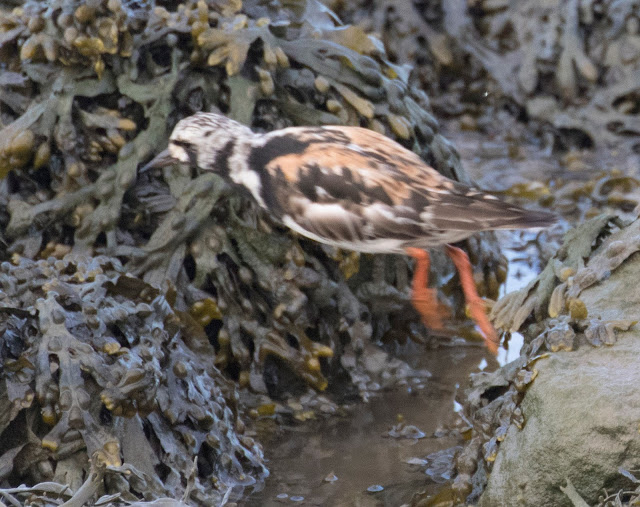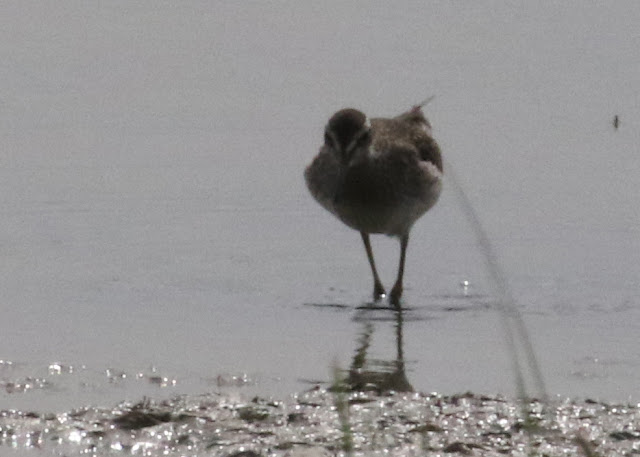Off to Llyn Brenig reservoir, where there were good common wildflowers, very few birds, and not much at all in the way of insects!
I was very glad to see more Smooth Hawksbeard, Crepis capillaris, along the roadsides, having identified it at Bod Petrual yesterday. This is the Hawksbeard I have most commonly seen in the past I think, and is said to be the only common one with smooth rather hairless leaves and stems. The involucre by contrast with the rest of the plant, is rather bristly, as with most Hawksbeards! The first thing to note about Hawksbeards is the distinct double row of involucral bracts, the outer ones either adpressed or spreading.
NOTE - in retrospect I would have liked to be more careful with my ID, as I feel it is potentially easy to confuse with the Marsh Hawksbeard, Crepis paludosa, although I think that is even more bristly on the involucre. These two species are most easily separated in fruit, and the relatively short achenes that I picked out the following day, did appear slightly curved, suggesting the Smooth Hawksbeard, Crepis capillaris. The Marsh Hawksbeard, Crepis paludosa, together with the Beaked Hawksbeard, Crepis vesicaria, are two of the few other species that I am ever likely to come across in Wales - together with the largely introduced Rough Hawksbeard, Crepis biennis.
If I look further into these I really do need another excellent Loupe lens! However even I was able to see that this plant branched from near to the base, eliminating the Marsh Hawksbeard, Crepis paludosa, from consideration, which only branches half way up. Another fairly obvious feature was the adpressed second/outer row of involucral bracts, a feature I believe only shared between these two of the commoner species, so if it isn't paludosa, it really should be capillaris! The styles should be yellow rather than blackish-green. A further difference is that the pappus of capillaris is a flexible pure white, while that of paludosa is a brittle yellowish or brownish-white, rather like a member of the Hieracium genus, with which it seems intermediate. Much less clear was any orange tinging to the outer florets, which may or may not be a feature of this species, among others.
The flowers are about 1 - 1.5 cm in diameter, but can be as much as 2.5 cm across. The involucre is generally wider at the base than the middle. The stem leaves are small and lance-shaped, with few lobes, apart from the two spreading basal lobes, that seem to gradually develop. The BRC Plant Atlas points out that it is a ruderal, and morphologically variable. The basal leaves, while present should be much more greatly lobed than the stem leaves, almost filigree, but I didn't see any of these!
These are the upper stem leaves, with their arrow-shaped backward-pointing lobes at the base.
I can compare this plant with the one tentatively identified at Cliffe Pools on the 6th September 2014. The colouring of the outer florets appears different, and the degree of darkening of the bracts, but the stem is similarly channelled. Also noted on Warkworth Beach, 26th June, 2015. The degree of variation is extreme, making it "polymorphic"!
I have already eliminated the Northern Hawksbeard, Crepis mollis, from the possibles, as it has not been found in Clwyd since 2000, and in only one tetrad then. A perennial with a short rhizome, it has a longer, 20-ribbed achene. http://www.bsbi.org.uk/Crepis_mollis_species_account.pdf. Worth keeping an eye out for though!
I was very glad to see more Smooth Hawksbeard, Crepis capillaris, along the roadsides, having identified it at Bod Petrual yesterday. This is the Hawksbeard I have most commonly seen in the past I think, and is said to be the only common one with smooth rather hairless leaves and stems. The involucre by contrast with the rest of the plant, is rather bristly, as with most Hawksbeards! The first thing to note about Hawksbeards is the distinct double row of involucral bracts, the outer ones either adpressed or spreading.
NOTE - in retrospect I would have liked to be more careful with my ID, as I feel it is potentially easy to confuse with the Marsh Hawksbeard, Crepis paludosa, although I think that is even more bristly on the involucre. These two species are most easily separated in fruit, and the relatively short achenes that I picked out the following day, did appear slightly curved, suggesting the Smooth Hawksbeard, Crepis capillaris. The Marsh Hawksbeard, Crepis paludosa, together with the Beaked Hawksbeard, Crepis vesicaria, are two of the few other species that I am ever likely to come across in Wales - together with the largely introduced Rough Hawksbeard, Crepis biennis.
If I look further into these I really do need another excellent Loupe lens! However even I was able to see that this plant branched from near to the base, eliminating the Marsh Hawksbeard, Crepis paludosa, from consideration, which only branches half way up. Another fairly obvious feature was the adpressed second/outer row of involucral bracts, a feature I believe only shared between these two of the commoner species, so if it isn't paludosa, it really should be capillaris! The styles should be yellow rather than blackish-green. A further difference is that the pappus of capillaris is a flexible pure white, while that of paludosa is a brittle yellowish or brownish-white, rather like a member of the Hieracium genus, with which it seems intermediate. Much less clear was any orange tinging to the outer florets, which may or may not be a feature of this species, among others.
The flowers are about 1 - 1.5 cm in diameter, but can be as much as 2.5 cm across. The involucre is generally wider at the base than the middle. The stem leaves are small and lance-shaped, with few lobes, apart from the two spreading basal lobes, that seem to gradually develop. The BRC Plant Atlas points out that it is a ruderal, and morphologically variable. The basal leaves, while present should be much more greatly lobed than the stem leaves, almost filigree, but I didn't see any of these!
These are the upper stem leaves, with their arrow-shaped backward-pointing lobes at the base.
I can compare this plant with the one tentatively identified at Cliffe Pools on the 6th September 2014. The colouring of the outer florets appears different, and the degree of darkening of the bracts, but the stem is similarly channelled. Also noted on Warkworth Beach, 26th June, 2015. The degree of variation is extreme, making it "polymorphic"!
I have already eliminated the Northern Hawksbeard, Crepis mollis, from the possibles, as it has not been found in Clwyd since 2000, and in only one tetrad then. A perennial with a short rhizome, it has a longer, 20-ribbed achene. http://www.bsbi.org.uk/Crepis_mollis_species_account.pdf. Worth keeping an eye out for though!












































